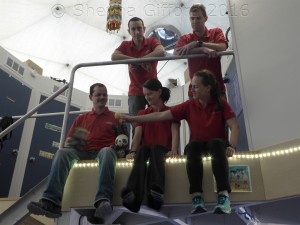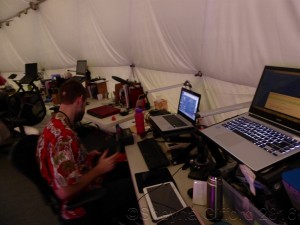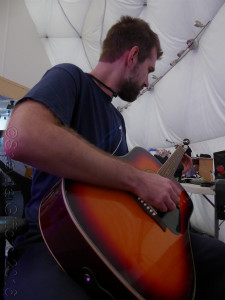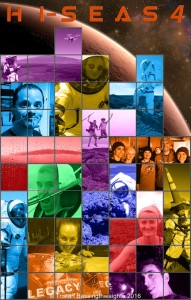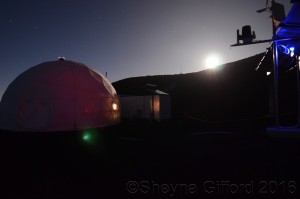Welcome to mission day 184 and the third quarter of our year on simulated Mars.
It’s been six months since my crew landed here. Half a year already! Though substantial evidence exists to the contrary exists – my hair is longer, the nights are shorter, and we now have a small fleet of tiny mutant tomato plants – in many ways, does seem like only yesterday that the white cargo van pulled up on the red rocks outside the bright white dome, and the six of us stepped out into our new world.
The beginning was very austere, almost business-like: grab your bags, get to Mars and get to work. Since I had been trying to get to Mars since about 1997, that arrangement suited me just fine.
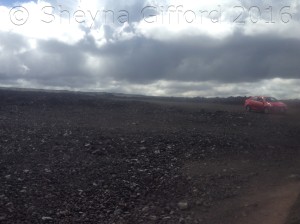 We waved at the cameras, saluted the administrators, and walked inside. I dropped my backpack in the first room I saw and began looking for something to do.
We waved at the cameras, saluted the administrators, and walked inside. I dropped my backpack in the first room I saw and began looking for something to do.
Our first task? Finding out where everything was.
About a month later, we had found most of the important stuff. It might be a faster on real Mars, but then again, maybe not. At present, we can only aim interplanetary payloads to within 6 miles of a target at best. As those pre-packaged bundles will be arriving months or years before we will, they may very well be covered by or buried in dust by the time we come looking for them. It’s not unreasonable to project that the first Mars mission might have a 1-2 month period dedicated to locating and assembling the various pieces of their habitat.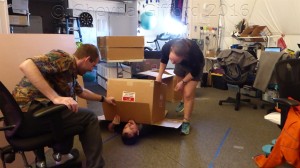
Locating and assembling is pretty much exactly what we did for a few weeks. As we sought out and discovered things we needed – water filters, spacesuit fans, spools of 3D printer substrate – we also found a lot of things that we didn’t need, or, at least, didn’t have a use for at the time: mini-basketball games; bags of golden Chinese new year prizes; mind-spinning varieties of duct tape (band-aid… batman… bacon?). That’s the sequelae of being mission 4, I suppose. It’s like being the fourth child in a family. We naturally inherited the worldly goods of the three missions who came before us. Tools and toys, scientific instruments and inside jokes. Though we can make absolutely no sense of it now, each item, in its own time, had its own logic – logic perfectly suited to those particular 4-8 months of confinement. Though I maintain that no logic to supports the existence of an I-Love-Justin-Bieber Sticker Collection on “Mars” or anywhere else in this galaxy, its uncanny presence here can only be explained by a prank, one on the order of Scott Kelly’s ape costume on the International Space Station. No one’s quite sure why it’s here, but hey, it’s kind of funny. Ha. Ha. *Looking around* Is it… still here? *Eep!*
As we located various kinds of equipment, from field cameras in heavy steel casings to lean spotting telescope parts and ungainly gigpan rigs, we figured out what we could do with them and how they worked, or didn’t. It was like landing in a science museum whose curators had gone out to lunch in the middle of assembling a new exhibit, and simply never returned. A bit of interplanetary sleuthing later, and we had a working dome, more or less organized into 9 sections: a semi-gourmet kitchen and pantry; a sea can (workshop/food storage/spacesuits/power systems); an airlock (more suits/radios/EVA gear); a biology laboratory complete with a chest freezer, an indoor garden and green bacteria growing in glass housings; a telemetry room full of computers; a laundry room; a dining room/books and games and a library/workout zone; and a common area with an electricity-producing bicycle, guitars, computer workstations, and an ancillary plant-growing area. Out back of the kitchen is the teleporter, where our compost and recycling go out, and where deliveries from resupply robots come in. Upstairs is where we sleep and keep the clothes we brought with us. That’s it, our dome on the range. Home for the last six months, home for the next six.
Once we had everything in place, we were able to establish patterns. Our days on sMars are a lot like a day in the life of most people on Earth, with a few significant differences. Like many people, we wake up and check email. Unlike most people, email is pretty much the only way that anyone can talk to us. People from work, from school, research colleagues, the media, our families: they all talk to us by email. We often spend spend hours checking email before the day even begins.
When our day does finally begin, we put on some sensors and monitors. How much we move around here, the levels of light and sound we experience, how much we interact with each other is all being tracked for science. Then we make breakfast, exercise, and do experiments for either NASA or for ourselves. We all have personal experiments that we run. Mine involve medicine, stress relief, injury avoidance, and what’s growing on us, the crew, as we all live in this small space together. If it’s my day to cook, I cook 2-3 meals for the crew. If it’s my day to clean, I clean out the composting toilets. Everyday, I exercise. I make videos for my husband and family, take care of medical issues if anyone has any, reply to requests from mission control, and help my crew mates with their projects. That’s my day!
And then, of course, there’s EVA. Always EVA.
At least twice a week, every week, come rain, sun, wind, fog, we find a way to go and play on the lava, at least for a little while. Exploring the world around us is arduous and even, as you may have read in my last post, a bit perilous at times, but it’s also joyous and amazi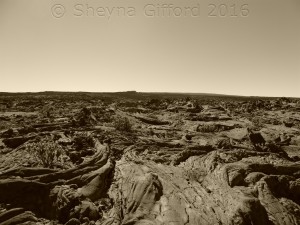 ng, and it’s what we’re here to do. We check out the radios, put on the suits, and go see what’s out there.
ng, and it’s what we’re here to do. We check out the radios, put on the suits, and go see what’s out there.
What’s out there can only be described as a roiling sea of primordial planet-matter, flash-frozen into a hundred-thousand facial expressions. Over the centuries, wide torrents of brick-red, rope-like grey, and coal-stack black lava rock tracked down this mountainside like tears, leaving questions and answers in its way. Have you ever been sitting across from a stranger on a bus or a train and noticed them crying or laughing? You had no context by which to understand why they were doing what they were doing. All you had to go on was what you could see in the present: their clothing, clean or in tatters; their hair, neat or neglected; their faces, worn with grief or smooth as sea stones. Otherwise, their histories were unknown and unknowable.
That’s what it’s like to 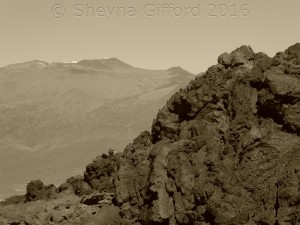 stand out on the lava fields now. You are surrounded by strangers, underfoot, all around. A million stories from different epochs of the Earth. If you can read the signs, you can peruse the history of the planet itself like the pages of a textbook. The way the rock is worn away here, revealing layers beneath it, is a tale of weathering and history of the types of flows. The streaks of colors laid out like stacked-up horizons show which kind of lava flowed fast or slow, smoothly or roughly forming hills and filling channels.
stand out on the lava fields now. You are surrounded by strangers, underfoot, all around. A million stories from different epochs of the Earth. If you can read the signs, you can peruse the history of the planet itself like the pages of a textbook. The way the rock is worn away here, revealing layers beneath it, is a tale of weathering and history of the types of flows. The streaks of colors laid out like stacked-up horizons show which kind of lava flowed fast or slow, smoothly or roughly forming hills and filling channels.
I’ll be honest – these stories are largely hidden from me. The same would be true if a geologist walked into a room with one of my patients. She or he wouldn’t quite know where to start. They would notice the very basics, perhaps: the person’s age, gender, and posture. If they looked sick or not, maybe. Then what? I feel the same way when I’m out on the lava. I’d like to ask it the standard questions, starting with, “What brought you here today?” But I don’t think I would get any answers.
Fortunately, my crewmates have the magic touch when it comes to things that flow, things that grow, and things that form themselves into various-sized holes in the Earth. If it weren’t for them, I would be lost when it came to our monthly geology task. As it is, I 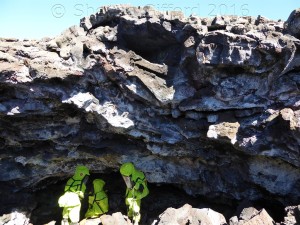 follow their lead as they rock out on the geology. I reap the benefits of their plant growth experiments, both in terms of physical beauty (the color green is amazing!) but also in terms of nutrition.
follow their lead as they rock out on the geology. I reap the benefits of their plant growth experiments, both in terms of physical beauty (the color green is amazing!) but also in terms of nutrition.
I’ve come to realize over these last few months that, while culturing foods like bread and cheese may be a good idea, growing plants in space is essential. For all the trouble they bring – taking up precious resources like physical space and water, requiring constant time and attention, almost like children – without them, the world just feels dead. I can’t imagine the habitat without the plants, nor would I want to.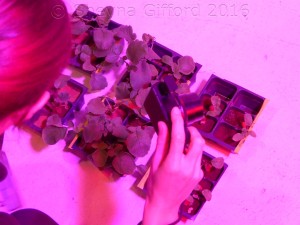
In addition to plants, other psychologically essential items have revealed themselves in the last half year. They include board games, musical instruments, and animal mascots. That’s right: we can’t have real pets, but we have plenty of plush ones. They have names like Raspberry and Trouble. They live on our desks and on our chairs, sometimes getting in the way as a real animal would. Unlike plants, they don’t require much maintenance. Also unlike plants, the plush animals can be animated for the purposes of pestering one’s crewmates during downtime.
Those things all turned out to be necessary. What wasn’t? With a few exceptions, all the things we left behind. Telephones. Online shopping. Traffic. Politics. Commercials. Politics. Pettiness. Holidays, interestingly enough. We were told, and are still told periodically, they they are important. But they don’t seem to have much meaning in a place where the environment rarely varies. Christmas? Well, sure, but it still looks like any day on Mars out there. Thanksgiving without our families was a bit strange as well. Also, have you ever tried to carve turkey made out of hundreds of rehydrated tiny turkey chunks? It’s a mess. Though, as it turns out, pressure-cooking craisins is a super-easy way to get decent cranberry sauce at a moment’s notice any time of year.
While holidays themselves are not necessary, vacations still are. Since we can’t go more than 2 kilometers away from the dome, a day off, a true day without a major commitment to answer emails or take care of a task for mission control, is about the most we could hope for. It hasn’t happened in 183 days. That’s about to change, however. By the time you read this, we’ll be in the middle of a real, true day off. In celebration of our 6-month anniversary, we’ll be running with no emails or computers for a single day. It doesn’t sound fancy, but that’s OK. Martians are studious and focused and very driven – and fun. We appreciate a good time, too, maybe more now than ever. What’s a good time on “Mars”? A book with real pages in it. Music. Maybe a movie. Sitting in the airlock as the light changes from bright white to gold. Standing by the porthole with a cup of tea, picking out faces in the rocks, watching the light play across the volcanoes in the valley, their tired peaks worn like hats that have seen too many sunny days and snowy nights. To be on sMars, and place the demands of Earth on hold for a day. That’s a Martian vacation.
HI-SEAS IV at the halfway mark: We’ve Gone Fishing Star-Gazing. Feel free to leave a message for the crew/fun recipe that can be made with shelf-stable foods/suggestions for 6-person board games/list of songs that sound good on the didgeridoo/well-wishes for the next 6 months at the beep…

